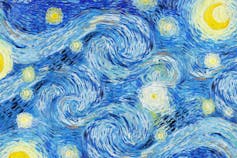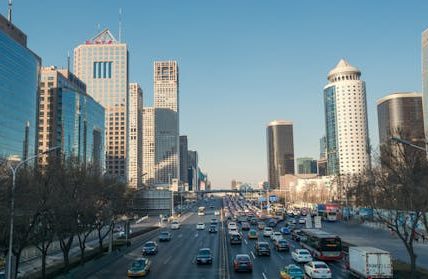Street lamps aren’t the only form of artificial light pollution – here’s how to create darker nights
Without a view of the stars at night, Don McLean would never have been able to write Vincent and Vincent van Gogh would not have painted Starry Night. Viewing a sky full of stars is part of what makes us human. The light from stars has travelled thousands of miles to reach our eyes.
But now, most Europeans live under unnaturally bright night skies. That ancient starlight is now diluted by human-made light pollution.
So where is all this extra light coming from? A recent German study reveals that, contrary to common assumption, public street lighting may not be the biggest cause of light pollution. The sources are closer to home. Improved energy efficiencies in LED technology means that artificial light is now cheaper than ever to run. As a result, people are lighting up front doors, sheds and garden paths like never before.
Artist Vincent van Gogh’s famous Starry Night painting was inspired by clear, dark skies.
Rawpixel.com/Shutterstock
Artificial light at night has undoubtedly revolutionised our productivity and transformed our social environment as the sun sets. However, when used excessively or inappropriately, artificial light at night becomes light pollution. This changes our outdoor spaces by creating daytime conditions at night.
In particular, LEDs emitting high levels of harsh blue-white light are known to scatter more widely into the atmosphere, increasing levels of light pollution, which can have unintended consequences by interrupting our sleep cycles and circadian rhythms and disrupting nature at night.
Just one lamp can attract hundreds of insects, many of them important nocturnal pollinators, away from their natural environment, every single night. Once trapped in what’s called the “vacuum cleaner effect” of artificial light, scientists estimate that over 30% of these insects will die before dawn from exhaustion or predation. This disrupts the balance of nocturnal ecosystems.
The German researchers used a specially developed mobile app called NightLights to survey sources of light at night. More than 250 citizen scientists surveyed their local surroundings. The results challenged common assumptions that streetlights are the primary contributor to urban light pollution, and showed that residential, commercial and other non-street lighting sources play a significant role in brightening our night skies.
Insects are attracted to lights on houses, in gardens and public spaces.
eleonimages/Shutterstock
In Ireland, we are coordinating similar surveys as part of a pilot programme to raise awareness of light pollution. Some of the most noticeable sources of night light include home security lights being angled up instead of down, garden runway lights over-illuminating pathways throughout the night and considerable light spilling from large windows without blinds or curtains.
Another growing issue in Ireland is the increasing intensity of illuminated sports grounds, often reported to the environmental non-profit group Dark Sky Ireland by concerned residents.
These issues can be easily resolved. Light pollution is just about the simplest of all pollutants to fix. Our study focuses on County Mayo’s Dark Sky Park, a place where naturally dark skies are protected and internationally recognised as a cherished form of natural heritage. We examined the role of dark sky tourism and community engagement in addressing light pollution. By making some simple changes to the type of light and being a little more judicious about how it is used, the level of unnecessary light currently polluting our night skies can be reduced.
Seeing the light
The community of Newport, County Mayo, has led the way in making these changes with some impressive results. Light pollution over the town of Newport has been reduced by 50% by redesigning the town’s lighting scheme – this award-winning project focused on replacing excessive flood lighting on heritage and architectural structures with a sensitively designed lighting scheme to enhance the town’s nightscape. As a feature of this initiative, the beautiful stained glass window at St Patrick’s Church in Newport, created by 20th-century artist Harry Clarke is delicately interpreted with light at night.
Lighting solutions that help protect dark skies include angling outdoor lights downwards and using shielded lamps to avoid illuminating the sky. Only direct light towards the area that needs to be lit, not into a neighbour’s garden or home. Use a visually warmer colour of light (such as amber) to reduce glare and improve conditions for wildlife and natural sleep cycles. Employing timers ensures that lights are only switched on when needed.
By making small changes to how we light our homes and gardens at night, the beauty of a starry night can be restored for generations to come.
Don’t have time to read about climate change as much as you’d like?
Get a weekly roundup in your inbox instead. Every Wednesday, The Conversation’s environment editor writes Imagine, a short email that goes a little deeper into just one climate issue. Join the 45,000+ readers who’ve subscribed so far.
Georgia MacMillan is affiliated with Dark Sky Ireland as a voluntary director (unpaid). Dark Sky Ireland is a non-profit CLG.
Marie Mahon receives funding from Horizon Europe
I am the Lead PI for the Research Ireland funded PhD project for Georgia McMillan. While I don’t directly receive/benefit the funds I have a role in managing them for Georgia.



